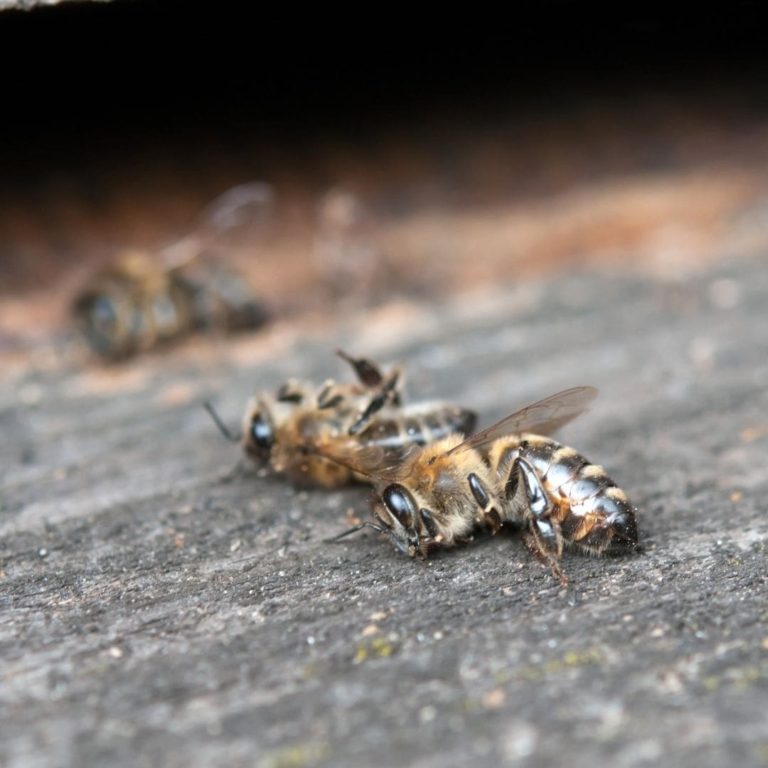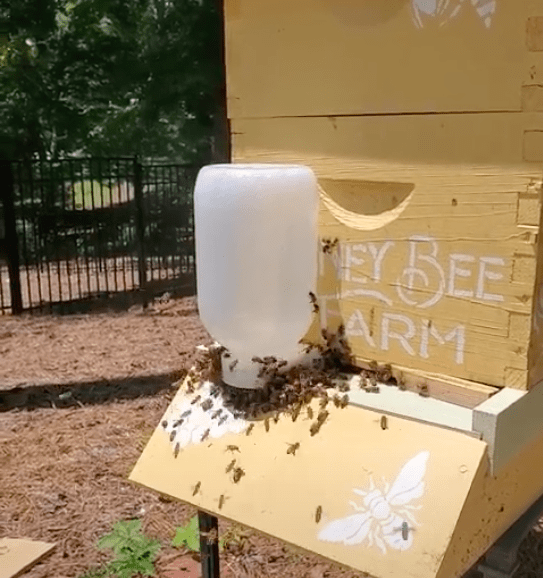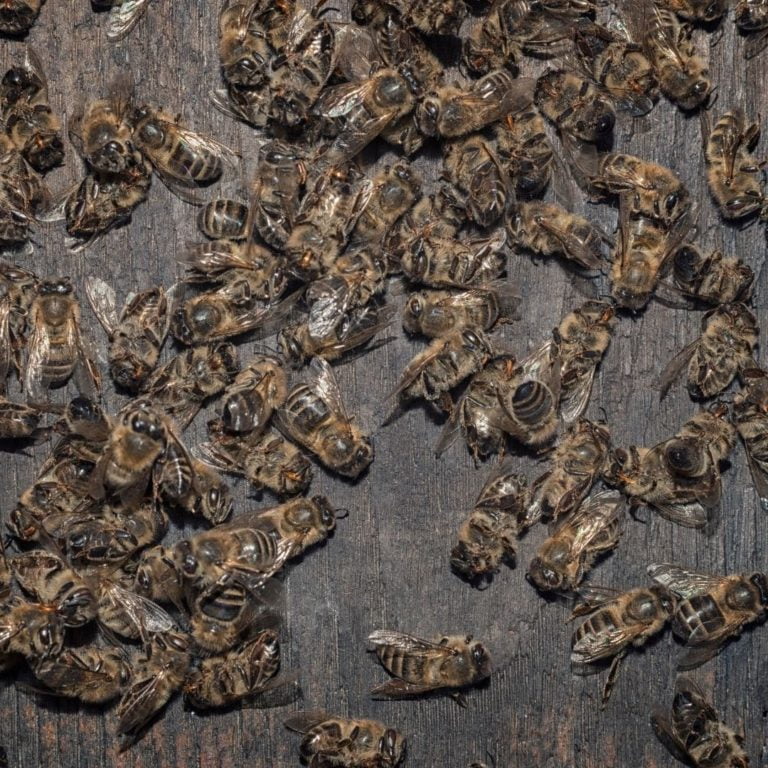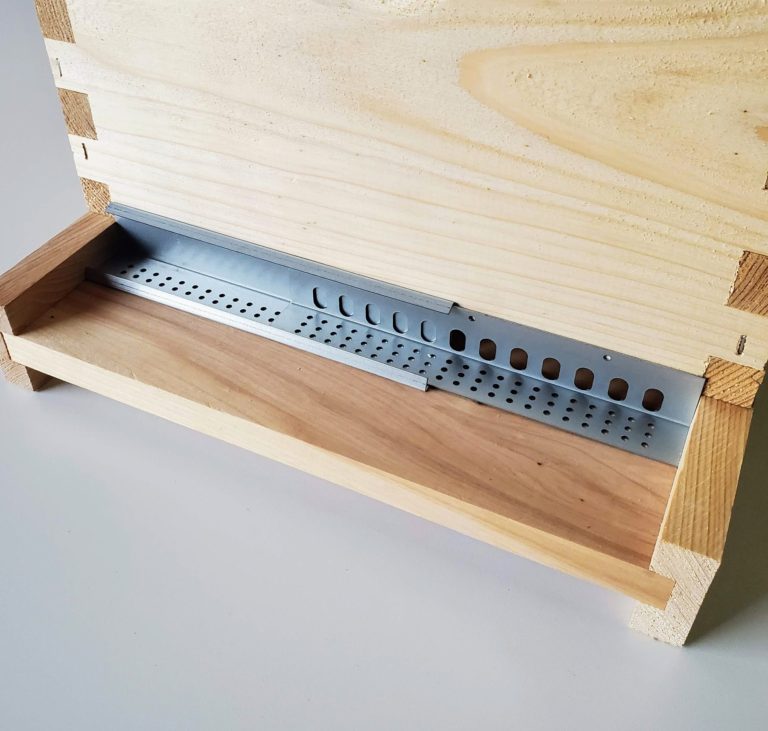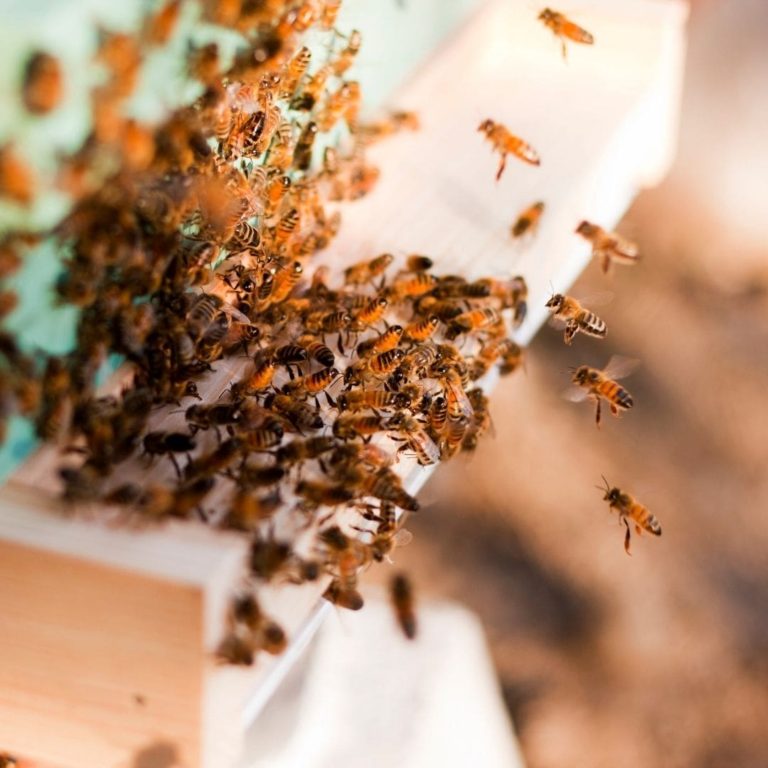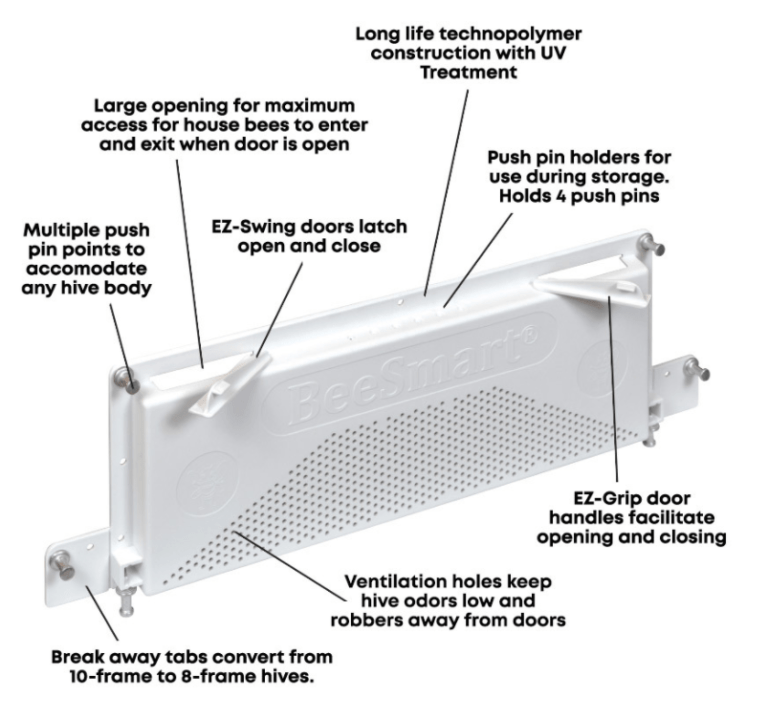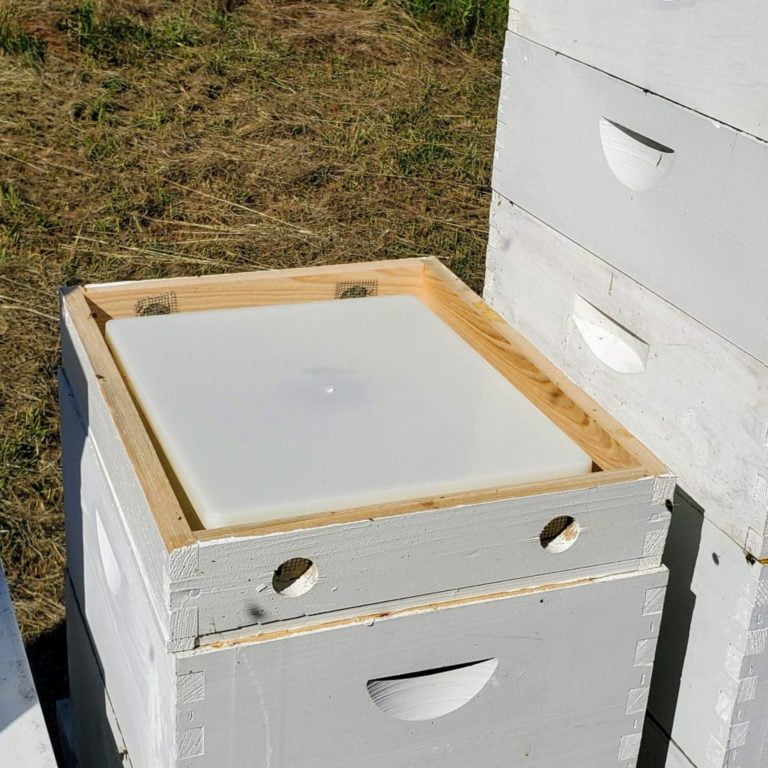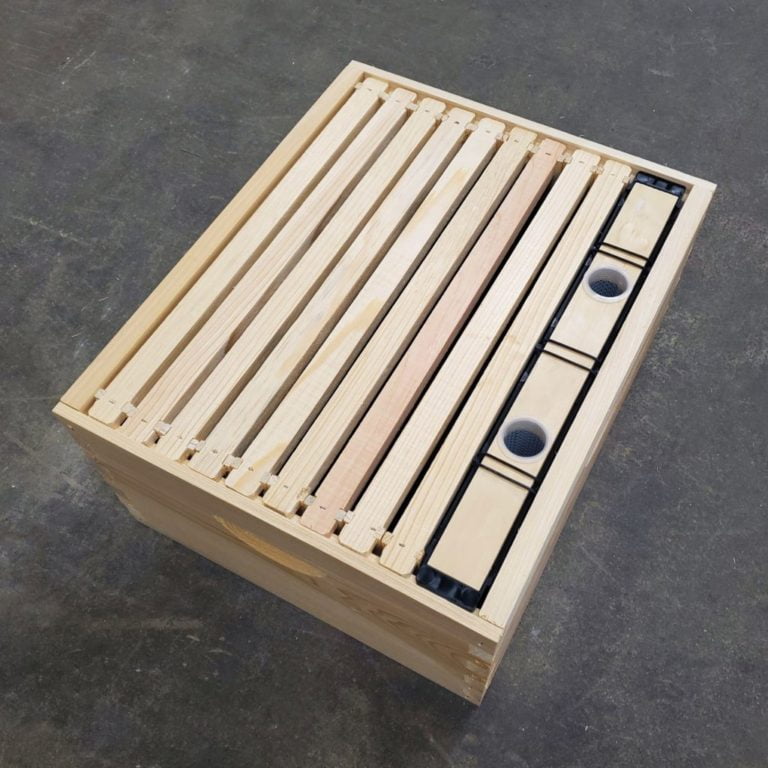What Is Robbing In Beekeeping?
Robbing is when one colony is stealing honey or nectar from the syrup feeder or the inside of another colony. Looting is the best analogy of robbing behavior in a hive. One colony with excess forager bees without a natural food source will look for weak colonies to take advantage of.
The robbing colony of honey bees are not looking to kill the weaker colony or queen, they are only after the honey or sugar water. Robbing bees will enter the weaker hive and quickly grab as much of what they can and return it back to their original colony. The robber bees will communicate where the weak hive is to other bees and they will all continue robbing the weak colony.
Robber bees are not trying to kill bees, the queen, steal brood, pollen or wax. They are only after the sugar water, nectar or honey.
Table of Contents
How Do I Identify Robbing?
One of the first signs that should stick out to you is increased intensity around your hive entrance as well as a higher pitch sound than usual (though this may not be easy to notice). Even on their busiest days, robbing activity is a significant step up from normal behavior.
If you suspect a hive is being robbed, the first step is to look at the entrance. Do you see bees fighting or do you see bees being dragged out from the hive? If so, those are likely signs that a raid is in progress and it’s time to act. Not seeing any fighting doesn’t mean you’re safe, the raiding colony may have overwhelmed your guard bee defenses and they may now be robbing with impunity.
Pay close attention to any bees that appear to be trying to enter the hive in unusual locations like any gaps between boxes, under the bottom board or 2nd entrance. Robbers will try to get inside another hive any way possible and will investigate each crack and crevice on the hive.
More Signs To Watch
Seeing bees actively “wrestling” with each other is the easiest sign of robbing, but there are a few others. If you haven’t seen it before, it can be hard to identify, but there are a few secondary clues you could use. Trust me, I wish I knew these when I saw robbing for the first time.
Tiny pieces of wax on your landing board. These are the cappings from your honey.
Dead or dying bees on the ground around your hive. The casualties of war.
No guard bees casually hanging out on the landing board. They’re busy being robbed.
How Long Will Robbing Last
So, how long will robbing behavior last?
Robbing could go on for days or hours. The robbing activity would only stop if the defending colony of bees drive them off or if they depleted all the honey in their target hive. It may take several days for the robbing activity to fully stop once it has started. This is because the robbing bees know there is an opportunity and they want to capitalize on the opportunity until they can’t anymore.
Remember, robbing is a crime and animals don’t have an understanding of social norms like right and wrong so even with best efforts at educating your own colonies about stealing from others, some will still break rank and try to steal from neighboring hives (This is a joke). You can’t stop your bees from robbing others.
You can only prevent your hives from being robbed.
Why Does Robbing Start?
Once you’ve seen a robbing frenzy in action, you’ll understand how destructive it can be to an entire colony or apiary. Robbing is not generally the primary cause of death for bees in a weak colony.
It is most likely that other issues like high varroa loads or a queen problem can put your colony in a state of weakness making it an easy target. Not all hives are candidates to be robbed, but beehives that already have issues are most likely to be robbed out.
It really all boils down to the bees having an opportunity to rob out another one. It’s like the big bully on the playground taking the snacks from the kid who can’t stand up for themself. Not the best analogy, but you get it. Often times the robber bees have the opportunity to easily access a hive through poorly maintained equipment like with a rotten pine box.
Since the dawn of agriculture, wherever there has been a hoard of vital resources, there have been those who attempt to take such resources by force. But long before any man or mouse had ever raided any granary, the humble honeybee had already perfected the art of the steal.
While it may be apparent when robbing is done by another species, robbing honey bees seldom wear ski masks and both teams are usually wearing the same jerseys so it’s not always obvious what is going on. I mean, how can you actually tell the difference between your own bees and the other bees invading your hive?
Robbing happen more in the late summer and fall when several conditions align, such as nectar dearth after a main flow, large colony populations with a high proportion of foragers, temperature suitable for flight activity. This combined with an increase of weak colonies do to summer stress and varroa mites creates a great opportunity for colonies to rob and be robbed.
There are many different methods and techniques that beekeepers can deploy to combat the robbing of their hives, some preventive and some reactionary. But robbing is one of those things that is going to happen from time to time, and the important thing is that beekeepers know what they are up against. Robbing can be combatted in many ways, but it helps if you know which strategy would work best in your situation.
Can Robbing Kill A Hive?
Robbing can not only cause a loss of honey, it will also kill bees and possibly your queen. Bees that are killed by robbers will often leave a pile of dead bodies on the ground or near the entrance point of the hive. Robbing can be so intense that sometimes the hive will become so depleted it cant sustain itself. The robbing will cause such irreparable danger that the colony is practically dead.
As I have said before, robbing is one of those things beekeepers hate to see but must do something about. Now you know how and when (if) you should act based on your observed bees activity and what you see. So, if a situation like this presents itself, its best to stay as cool and collected as possible while taking actions that will protect your bees and help the hive recover from this temporary robbery.
How To Stop Bees From Robbing Your Hive
Although bees are able to defend their hive and recover from moderate robbing, robbers can also kill your queen and steal so many resources that your hive never recovers, act immediately to save them.
Simply put, you are wanting to keep the robbing bees from getting into the weak hive. It’s not necessary to divide the bees out, you just need to keep the robber bees from getting in. There are many ways to do this, but the important thing is you do something to help.
It may take several days to break the robbing cycle after the initial robbing activity is stopped. This is because the robber bees will just keep coming back to try and start robbing again.
In this colony in the picture, it was suffering from a robbing situation where the entrance feeder was attracting robber bees. We removed the feeder and changed it to an internal feeder. We reduced the entrance down to about the size of 2 bees and piled pine straw on the front.
The pine straw on the front was loose enough to allow bees to get out, but tight enough to make it harder for robber bees to get in.
Immediately after doing this, the robber bees starting looking at other places on the hive to get in.
The pine straw was left on there for a couple days until all robbing behavior was gone.
Reduce The Entrance
There is something called a robbing screen that could be used, but there are quicker solutions that are easier to do.
Remember, robbing starts because there is an opportunity for a stronger hive to steal from a weaker hive. The quickest option is to reduce the entrance to the hive to only big enough for 1 or 2 bees to come and go at once. You can use an entrance reducer, sticks, mouse guard, rocks, a brick, entrance feeder, whatever you’ve got.
Just make the entrance smaller so your bees can better defend their entrance. Think of it like the entrance to a castle, the smaller the entrance, the easier it is to defend.
Close The Entrance
Remember the kid that was a poor sport and when he (always a boy for some reason) was losing, he would pick up the ball and go home. It’s time for you to be that boy for the sake of your bees.
Robbing can’t happen if you close the entrance completely. This will cause a major traffic jam and lot’s of confusion, but it will stop the robbing. Closing a hive will make it hot, so don’t close off the screened bottom board and if you are in a place with those crazy summer temperature (I’m talking to you Texas), you might want to try and shade your hive or don’t even try this.
The entrance can be closed off with a stick or similar object, or a wet towel can be placed over the entrance to block it off. These reducers can double as a reducer and a moving screen and can be very helpful with robbing. Wetting the towel helps to keep it in place until it can be take off later.
You would only do this for an hour or two until the robbing stops. After that, you can reset to the reduced entrance to help your bees better defend it. Be aware, robber bees will probably be back later so be prepared for when they try again.
What Is A Robbing Screen?
Robbing screens are a type of plastic or mesh cover that attaches over the existing entrance of the hive which changes the direction of the bees entering and leaving their hive. They have an open mesh front that confuses any bees wanting to rob the hive because they can see inside the hive, but can’t easily figure out how to get there.
If you’d like to avoid these other steps entirely, the simple remedy is the robbing screen. They are an easy to use and highly effective solution that can save you both stress and bees.
These can work great as a preventative measure for your hives because your own bees will learn how to enter and exit their hive easily, while leaving any bees wanting to rob it out confused.
Additionally, robbing screens have the benefit of protecting your hive from other robbers including mice, wasps and hornets. They also prevent what is called drift, where bees from one colony end up staying in another hive for a night or two, usually drones. This is thought to be a major source of disease transmission between hives so it’s not a trivial bonus feature.
How To Use Robbing Screens
Robbing screens can be installed year around, but they will interfere with other activities like feeding or cleaning out the hive. For this reason, they are typically put on before robbing season starts (during the hottest part of the summer).
The method of installation depends on the kind of screen you choose. While there are a few types of robbing screens, most of your choice lies in what they are made of and how you put them on as they all function the same way.
If you are a traditionalist who likes the wooden look, you have many options to choose from. These will typically install with either nails or screws, although they can also be installed with bungee cords around the hive.
If you prefer the functionality and economy of polymers, the BeeSmart ultimate robbing screen is hard to beat. It features push pin installation which many may prefer to the options which nail or screw into your hive.
How To Use Robbing Screens
Robbing is caused by having more bees foraging than there is nectar to go around. This happens particularly around the hottest and driest time of the year in what’s called the summer dearth. At that time, nectar slows significantly and bee colonies are full of foragers after coming off their main honey flow.
If you’re being robbed, it is likely a sign of some other weakness in your colony. The best way to prevent robbing is by keeping a healthy colony of bees with a well laying queen who are all well suited to the amount of space they have to defend. This means don’t make the entrance too big and don’t be afraid to reduce it down proactively. More tips and tricks from experts can be found here.
Hive inspections, honey removal and feeding are all major triggers of robbing behavior. Be sure not to drip any sugar water or honey around the hive which can set off robbing. If you open the hives up, be quick with the inspection or honey removal.
Keeping your entrance reduced as well as maintaining your equipment in good condition (meaning no holes in the equipment) can both aid in preventing robbing. Only remove your entrance reducer when it starts to significantly restrict the flow of the bees during a honey flow and only when the hive is well populated with a strong colony.
Feeding During The Summer Dearth
Let’s be honest, there isn’t a perfect time to feed your bees and during a summer dearth is one of those. We don’t like to have to feed our bees, but sometimes it’s necessary, even during the worst time of the year.
The most significant trigger to increase the odds of robbing would have to be feeding, specifically the type of feeder you use can make a difference so let’s take a look at your options.

Avoid Using Any Supplements
Bees will naturally drink sugar water, but there are times when you want to give them something extra to make them drink it faster or for some health reasons. Feeding supplements like Honey B Healthy, Pro Health, Hive Alive and other products will make the sugar water more enticing to robber bees.
If feeding during a dearth, please don’t add those supplements because it could possibly cause a problem. Wait until the summer dearth is over before using those products.
Feeders <> Robbing
Entrance Feeders
Entrance feeders are easy and convenient to use but anything sweet at the front of your hive raises the risk of robbing. Because they drip sugar water right near the entrance, it can be difficult for guard bees to defend.
If using entrance feeders during a dearth, move the actual entrance to the hive the the opposite side of the feeder so that it would be more difficult for robbing bees to access the feeder.
Top Feeders
Top or Inside feeders are generally a good idea during a dearth. They place the sugar water in roughly the same location the honey would be otherwise, allowing the bees to guard the hive in a similar manner.
The top feeders make it easier for the colony to defend it. Robbing bees will have to travel all the way through the entrance and up into the hive to rob out the feeder. Because of this, if you are feeding during a dearth, these are a good option compared to open feeding and entrance feeding.
Frame Feeders
Frame feeders are a great option for feeding during the summer dearth. They are an internal feeder that takes the place of 1 or 2 frames. The feeders are easier to defend against robbers compared to entrance or Boardman feeders. They can also hold more than many other feeders so you would have to refill them less often.
The more you feed the colony in the summer, the more opportunities there are to spill sugar water.
Open Feeding During A Dearth
Open feeding is where you place a feeder 200-300ft away from any of your hives to allow all the bees to feed. When feeding your hives using an open feeder, you are creating a robbing event, but it is at the feeder instead of at a colony.
But once the feeder runs out, the bees are still in a frenzy and will likely start robbing out weak colonies in the area. Besides being somewhat inefficient, open feeding can actually cause more problems than it solves.
Finishing Up
Robbing is a problem that can happen to any beekeeper, and it’s important for them to be prepared in case this happens. There are many ways to prevent robbing from happening at all or stop it if you see the warning signs before they become too serious.
We have provided some helpful tips on how to keep your colony safe in our other blogs, so take a look at what we’ve written! If robbing seem like something that might affect your honeybees (or others), then it’s important to act now.

